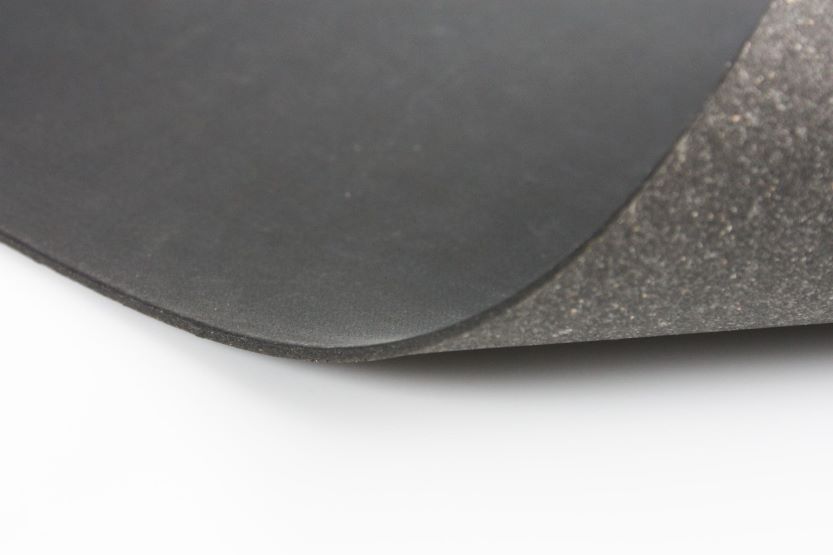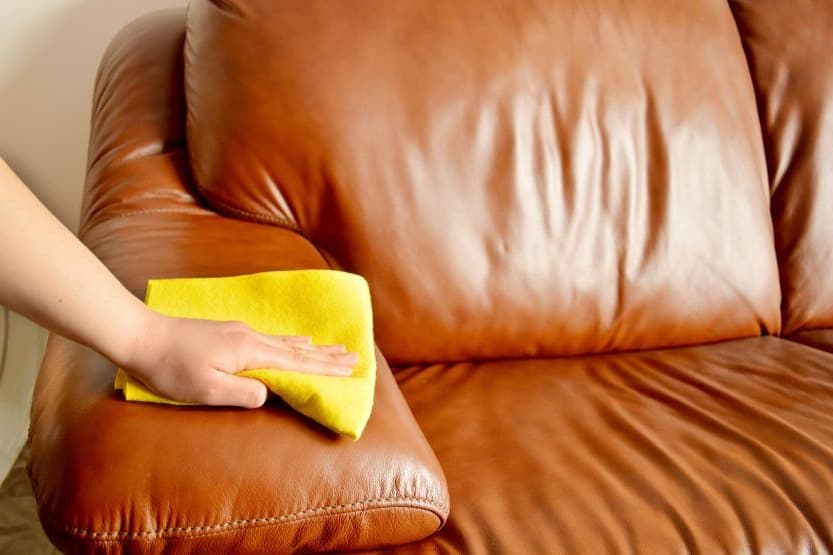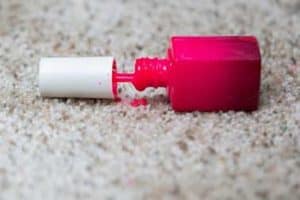If you are shopping for leather furniture, it is common to see the material is bonded leather. What is bonded leather? Is bonded leather real leather?
Bonded leather is a mixture of both fake and genuine leather. Bonded leather is made when manufacturers process leftover scraps of genuine leather and combine them with a polyurethane binder. Generally, only about 10-20% of bonded leather is real leather.
The benefits of bonded leather are as follows:
- It is cheaper.
- It is eco-friendly.
- It is easy to clean.
- It comes in various designs.
- Maintenance is cheaper.
The negative aspects of bonded leather are as follows:
- It is not as ‘soft’ as real leather.
- It is not as durable as real leather.
Some manufacturers market their bonded or blended leather as real leather. So, you have to be cautious when buying furniture, whether you want to buy bonded leather or not.
Read on to learn more about blended leather, bonded leather, and real leather, including how to care for your bonded leather.

Is Bonded Leather Real Leather?
Bonded leather is what others may call an alternate to real authentic leather. Real leather consists of skins from animals, while bonded leather has only a small amount of real leather. These real leather scraps are then combined with other materials, such as polyurethane binders to produce bonded leather.
What Is Bonded Leather?
Bonded leather only uses scraps of leather remnants, which comprise between 10-20% of its content. This fact indicates that bonded leather doesn’t use an animal’s whole skin but only the leftover pieces of the hide.
How Is Bonded Leather Made?
Bonded leather is made using scraps of leather that are turned into a pulp and stuck to a fiber or paper backer. The end-product is then coated with polyurethane and embossed so that it could look like real leather. Some companies add color and synthetic materials, lending a particular odor to the end-product.
Now, we discovered the answer to the question: “Is bonded leather real leather?” Therefore, it would also help to understand what real leather is.
What Is Real Leather?
Real leather originated from animal skin, more commonly cowhide, to produce materials that manufacturers can utilize to create various useful products. Another alternative to cowhide skin is goat and buffalo hides. Also, you can include exotic leather, such as snake and alligator. These animal skins are durable and are considered high-quality materials, making them pricey.
Pros and Cons of Bonded Leather
Whether you buy real leather or bonded leather, you have to know all their pros and cons. You can correctly decide when you know what you’re getting yourself into.
Bonded Leather Pros
1. It Is Cheaper
Buying bonded leather will save you money because it is cheaper than real leather. You can save hundreds of dollars by choosing bonded leather over genuine leather, as it is budget-friendly. Even though real leather is more durable, you can prolong the lifespan of your bonded leather by maintaining and caring for your bonded leather properly.
Real leather may have a longer lifespan, but if you don’t know how to maintain it, it will end up being damaged quickly than your blended leather. Hence, keeping your bonded leather correctly will extend its durability to equal that of real leather.
2. It Is Eco-Friendly
For some people, bonded leather is preferable because it is eco-friendly. It’s environmentally friendly leather because bonded leather only uses scraps of real leather. The percentage of animal skin used is 10-20%, which means it only uses scraps of the hide. Manufacturers don’t have to do additional animal farming, thereby reducing wastes significantly.
If you’re an environmentalist, you don’t have to worry about how many animals died for your bag or shoes. Your item has only a small bit of animal skin, and these are ‘leftovers.’ I don’t know if that would still be ‘horrible’ for you, but nothing in this world is ever perfect.
You may not know it, but there may be items that you’re using right now that have bonded leather as their base material. Examples are watches, belts, shoes, bags, clothing, and many more.
3. It Is Easy to Clean

Not only is bonded leather environmentally friendly and cheaper than real leather, but it is also easy to clean. You can use a damp and dry clean cloth to clean it. You don’t need expensive cleaning solutions or gadgets to maintain its cleanliness.
For more of the cleaning process, you can refer to the topic of cleaning your bonded leather, presented below.
4. It Comes in Various Designs
Bonded leather comes in a wide range of design options as it can easily be tailored and handled. You can also have your item customized if you want to. Besides, the bonded leather product could come in a variety of colors and styles as well.
5. Maintenance Is Cheaper
The bonded leather’s maintenance is cheaper if you do it correctly. Cleaning your bonded leather often is one of the keys to proper maintenance. All you need is a leather conditioner and a clean white cloth.
Never leave a spill on your bonded leather without cleaning it. Putting off your cleaning process can cause damage to your product.
When stains appear on your leather’s surface, wipe it off quickly with a damp cloth and then with a dry cloth. Maintenance is cheaper when you act immediately.
Bonded Leather Cons
1. It Is Not as ‘Soft’ as Real Leather
Bonded leather may look like real leather, but it will feel thin to the touch and not as soft as real leather. Bonded leather also peels and cracks more easily than real leather. This will cause flaking off of the material.
2. It Is Not as Durable as Real Leather
Real leather would outlast your bonded leather, as it is 100% animal hide. The other materials used in manufacturing the leather can easily peel and crack, increasing its risk to wear and tear. Its estimated lifespan is two to three years.
What Is Bonded Leather or Blended Leather Used For?
Is bonded leather good? Yes, because you can use it for many things, such as upholstery, bags, shoes, belts, watches, and many more products. Bonded leather is commonly used for upholstery in your car or your home furniture.
Hospitals also often use bonded leather in their chairs, beds, tables, and other hospital equipment.
Office equipment also makes use of bonded leather often. No office doesn’t have one or more bonded leather products.
So, bonded leather is useful everywhere and anywhere and is used by many professions in their businesses and personal lives.
Tips on How to Care for Bonded or Blended Leather
When stretched, the pieces of leather can separate, thus causing it to peel. So, it needs to be taken care of and maintained. Before buying bonded or blended leather furniture, you should first learn how to maintain the material.
1. Preserve the Bonded Leather by Using a Leather Conditioner

You can buy a leather conditioner and use it regularly to prevent the peeling and flaking of your item. All you have to do is apply it with a clean cloth and wipe it dry with another clean cloth. The conditioner will protect your bonded leather’s outer surface and decreases the risk of damage, scratching, or peeling.
2. Learn How to Use a Leather Repair Filler/Kit
You can use a leather repair kit or filler to repair the peeling parts of your leather. This is one sure way to maintain your bonded leather properly. However, you have to do the repairs as soon as the peeling starts to appear, as the kit cannot repair severe damage to your leather.
You would have to replace your item when it becomes impossible to repair. Remove the protruding bits first, and then add a dyed patch that matches your bonded leather color.
3. Avoid Exposure to Dirt or Grime
Exposure to dirt or grime will damage your bonded leather quickly. So, you must store your item in a protective case or container. If it’s a bag or shoe, placing it inside covered shelves would prevent its exposure to these harmful materials. You could also put them inside soft cotton bags to avoid friction.
4. Avoid Exposure to Direct Sunlight
Direct sunlight weakens and damages the bonded leather’s material increasing the risk of damages. Heat compromises the bonded leather; hence, don’t place it near hot areas, such as ovens, stoves, or fireplaces. Anything hot is a red-zone area for your bonded leather.
5. Clean the Bonded Leather Regularly
You have to regularly clean your bonded leather to remove oils, dirt, or spills that can damage it. Since it’s made from non-elastic material, it can accumulate dirt between its fibers, so cleaning them often would prevent the accumulation of dirt between the leather’s fibers. Make sure to wipe clean the corners or hidden portions of your product.
6. Avoid Harsh Chemicals
When cleaning your bonded leather, avoid using harsh cleaning solutions and chemicals. The harsh cleaning solution can damage your leather. Also, test the leather conditioner first if it isn’t color-fast. This process prevents the bonded leather’s color from fading when it comes in contact with the conditioner.
How to Clean Bonded Leather
You can clean bonded leather by wiping any dirt or debris with a clean damp cloth. Don’t soak the leather with water or detergent. Afterward, wipe the remaining dampness with a clean, dry cloth. You should not use detergents or other abrasive cleaners as these can damage your leather. Wipe off spills immediately as they tend to stain bonded leather materials.
Stay out from untested leather conditioners as well. Use only conditioners when consumers recommend them. Your bonded leather product is not a testing item for manufacturers.
How to Repair Bonded Leather Scratches
Consumers can expect small scratches on their bonded leather as it is not real leather. For small repairs, you can use shoe polish. Nevertheless, for bigger damages, you can quickly repair this by following these steps:
1. Clean the bonded leather thoroughly with a white, clean cloth. Carefully wipe off stains and spills on its surface without scratching it.
2. In an appropriate container, mix a leather repair solution using the proper color. The color has to match the color of your bonded leather product.
3. Apply enough amount of the mixture to the affected area and around it. Ensure that you have covered the hidden parts too.
4. From your repair kit, get a leather-grained paper and place it over the repair area. Make sure that the entire area is covered.
5. With a warm iron, gently iron the area until the pattern is transferred. Avoid using a too-hot iron because this can damage and discolor your bonded leather.
6. Allow the bonded leather to dry or cool before using it again. You may want to keep it inside a shelf first, for a few days, so it can ‘rest’ for a while and ‘recuperate’ from the repair.
Conclusion – What Is Blended Leather? Is It Real Leather?
Bonded or blended leather is not real leather because it has fake leather material in it. Bonded or blended leather is a mixture of fake and genuine leather; so, you cannot honestly label it as real leather.
Manufacturers process leftover scraps of genuine leather, combining it with polyurethane binder to produce bonded leather. Although they claim the product as real leather, bonded leather is still not real leather. Yes, it may consist of real leather, but it only has 10-20% of the genuine material.
Bonded leather, however, has various advantages you can benefit from, as it’s cheaper and eco-friendly.
You can choose what to buy between real leather and bonded leather based on your purpose and preferences. But you may want to give bonded leather a try. You only have to take care of your bonded leather properly to make it last longer.
Related reading:
How to Clean a Microfiber Couch, Fabric Couch, or Cloth Couch
How to Clean a Couch? Cloth, Microfiber – 6 Steps




